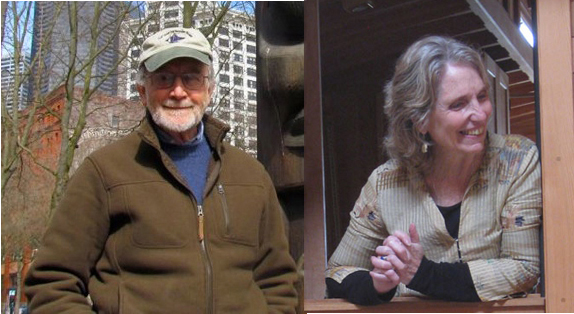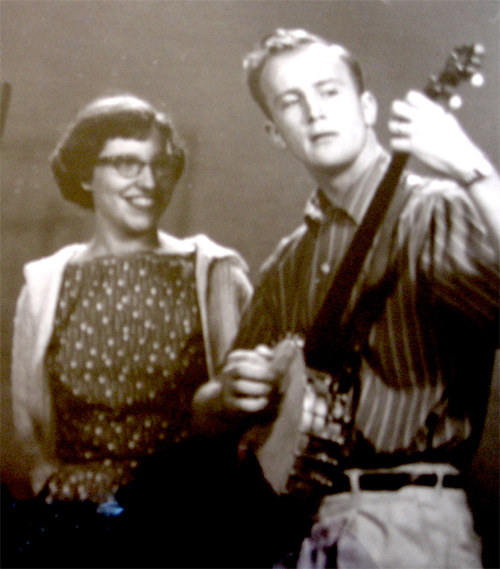
SEATTLE FOLKSINGERS
THOSE WHO LED THE WAY
JOHN ASHFORD & SALLY PUSHKARA ASHFORD
By Bob Nelson
In these articles titled “Those Who Led The Way” I want to bring to you the stories of five folksingers who were very influential in the Seattle folk music scene of the 1950s and '60s. The first three articles presented Walt Robertson, Don Firth, and John Dwyer. In this final installment I delight in presenting John and Sally Ashford, who’s lasting legacy is one of fostering community singing and the teaching of our rich heritage of folk music.
From time immemorial, people have sought comfort and enjoyment from gathering together and singing songs. The Pacific Northwest is rich in written records of the earlier explorers and settlers who came together with music. In 1859, the well-known Northwest diarist James G. Swan mentions such occasions in the beaches of Willipa bay. In the 1890s, “The Old Settler”, written by Judge Frances Henry, was often sung in the drinking spots of early Olympia. In the 1930s, the family radio became another gathering place for music. In the 1940s, Ivar Haglund and James Stevens were frequently heard on Seattle radio. Burl Ives had a weekly radio show. By 1953, Walt Robertson and Sheriff Tex had a weekly television shows. Despite the snobbish put-downs of the musical East-Coast establishment, Seattle was NOT the “musical dustbin of America.”

Sally Pushkara Ashford and John Ashford
I met John and Sally (aka Pushkara) Ashford in the mid 1950s at Eagleson Hall, in Seattle’s “U” district. They had just formed a singing club called “The Seattle Folksinging Society.” As soon as I learned of this group, I quickly became a member. We became an amazing collection of young people, old people, entire families, University professors, and strange and wonderful individuals whose common ground was a love of these songs and the sharing of the voices. John and Sally organized the group well by planning programs of group sing-a-longs (complete with song sheets they supplied) soloists, duets and small groups that prepared and practiced for these monthly gatherings. To say that they were instrumental would be to make a pun, something I’ve never been known to do.
I can still see the faces and hear the voices of such folks such as Nancy Hubbard, Irwin Nash, Ron Ginther, Mary Balmer, Jim Morrison, Dr. David Fowler, Don Firth, Dorothy “Lofty” Loftus, Gordon Tracie, and so many more. As we were a diverse group, we all became comfortable in singing rounds and songs in Swahili, French, Spanish, Finnish, Swedish, Norwegian, Afrikaner and Mexican. Our membership soon approached 100. As we became known, we also became a destination point for singers who were on the road. We hosted such performers as Roy Guest from England, Eric Sackheim, Pete Seeger, Bob Gibson, Guy Carawan, Peggy Seeger, Elizabeth Cotton, and Doc Watson. and others.
Another popular activity, led by John and Sally, was the formation of small groups of duos and trios and choruses. Then we would sing at hospitals, old folks home, schools, and union halls. It was a very exciting and rewarding time. Folk music was alive and well in Seattle!
John Ashford came to the scene with perhaps more credentials than most of us. John’s father, Paul Ashford, had been employed by the WPA as a writer. During his travels, he became a folklorist and song collector. John recently donated his father’s collection to the University of Washington. While John was still a youngster his father used to bring his friends home for Sunday dinners and to gather around the family piano. It was here that first met the likes of Pete Seeger, Woody Guthrie, and Ivar Haglund.
One of my first impressions of John coincided with my early introduction to the five-string banjo. Unlike most of the banjo players I’d met by that time, John could not only tune his banjo, but he could launch into some of the most amazing finger work I’d seen. He had full command of his instrument. In fact, John had just returned from a cross-country trip to spend some time in Ohio with the legendary Pete Steele. As he told of that journey, I got a sense of the seriousness of John’s quest for the authentic folk music.
Here is John playing Pete’s Steel’s “Payday At Coal Creek Today.”
Payday At Coal Creek Today
John’s voice was a delightfully clear tenor. He knew how to use it well to project the stories and feelings of his songs. Listen now as John sings the lead of the Irish song “The Old Man’s Lament.”
The Old Man's Lament
And here is John with an a cappella version of “Daily Growing.”
Daily Growing
Sally (aka Pushkara) also had strong musical roots. She grew up in a large family that always sang. The family was politically involved and social activism was encouraged. She had an early exposure to the power of music. Participation in public rallies for this cause, or that cause, was a common event. As recently as 2008, the mayor of Seattle honored her mother, Irene Hull, by declaring an “Irene Hull Day” and thanking her for years of social activism.
Sally’s voice went through much growth and maturity. When I first knew her as a teenager, her voice was strong and forceful. But with serious study, her voice became very full and rich. Listen to her wonderful singing of “The Night Visiting Song.”
The Night Visiting Song
Here is another of my favorite selections “Un Candien Errant.”
Un Candien Errant
One of my most lasting memories of Sally’s singing occurred during a Pacific Northwest Folk Festival at the Seattle Center in the 1970s. I was walking across the grounds when I heard some group singing coming from some place that I couldn’t see. I went searching for the source and discovered a group of perhaps 20 people sitting together on the steps leading down to the side entrance of the Key arena. This area became a small amphitheater that echoed with the voices raised in song. I still get goose bumps when I remember Sally’s voice leading everyone in “Who Will Sing For Me.” Tragically Sally lost her voice about 1981.
John and Sally also joined with Ron Ginther and as a trio they became “The Cascades.” Here is an example of the trio singing “Blow Ye Winds Southerly.”
Blow Ye Winds Southerly
Shortly after John returned from his musical sojourn, he and Sally married. Their home soon became a gathering place for hoots, jam sessions, workshops and rehearsals. They also began mentoring fledgling musicians and giving voice and instrument lessons. You name it and something musical could always be found at their home. Throughout the 1960s and '70s, their Ravenna area home continued to be a warm gathering place for hoots and jams. They were instrumental, both as hosts and organizers of the early Seattle Song Circles.
In closing let me present two more songs from the archives. This first one, “La Dee Ray” was recorded at a concert at the Everett Public Library in 1976. And here they are singing a delightful a cappella version of “The Fox.”
La Dee Ray
The Fox
Today, Sally has carved a new life for herself on the south tip of Whidbey Island. You can visit her website here.
John and his wife Jen live in the West Seattle area where they both continue to scratch their itchy feet in worldwide travels.
This article concludes the series “Those Who Led The Way”. These were all strong singers, collectors and leaders in the folk music community. Collectively they showed us the way. Individually they each made a lasting impact on many of us. We are all the richer for the years of dedication and hard work.
Bob Nelson
RETURN TO SEATTLE FOLKSINGERS